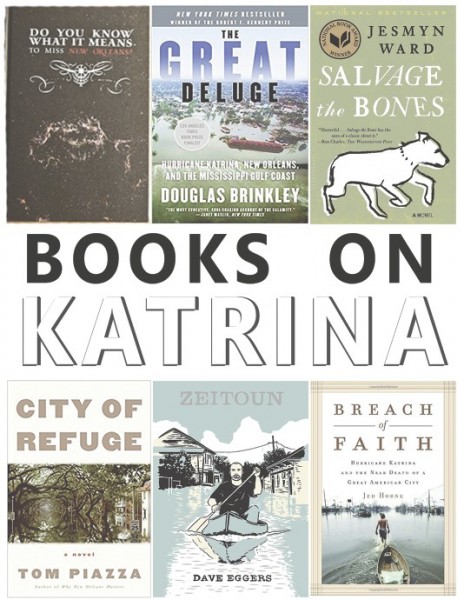The Floating World tells compelling narrative of Hurricane Katrina

Anh Nguyen | Associate Artist
In addition to C. Morgan Babst’s “The Floating World,” here are six other breathtaking novels about the strife of Hurrican Katrina: (left to right) “Do You Know What It Means to Miss New Orleans?” by David Rutledge, “The Great Deluge” by Douglas Brinkley, “Salvage the Bones” by Jesmyn Ward, “City of Refuge” by Tom Piazza, “Zeitoun” by Dave Eggers, “Breach of Faith: Hurricane Katrina and the Near Death of a Great American City” by Jed Horne.
In her recent historical fiction novel, “The Floating World,” author and New Orleans native C. Morgan Babst weaves an enthralling narrative of love and loss that is a must-read for casual readers and literary experts alike.
Set in and around the greater New Orleans area before, during and after the events of Hurricane Katrina, Babst’s tale succinctly and holistically exemplifies the age-old adage “less is more.” Instead of assessing the sociocultural consequences of Katrina quantitatively, she chooses to paint — in the intuitively perceptive tones only befitting a local — a vibrant tapestry of heartbreak, hardship, endurance and perseverance as seen through the eyes of a single, disaster-torn family.
Though Babst’s bleak portrayal of post-Katrina New Orleans as a barren, sodden, near-uninhabitable wasteland effectively provides a thematic backdrop for the events of the book’s plot, “The Floating World” is, at its core, an inherently character-driven work. It is the startling humanity, relatability, and believability of the key characters that propel the plot forward and sustain its momentum, captivating the reader irresistibly.
The main cast consists of the five-piece Boisdoré family and features their friends and extended community as supporting characters. Following Katrina’s catastrophic destruction of New Orleans, Joe Boisdoré and his wife Tess return home to ruins both physical and familial.
Not only is Joe’s elderly father, Vincent, succumbing to his worsening dementia and rapidly becoming more of a danger to himself by the day, their daughter Cora has become disturbingly withdrawn as a result of a mysterious tragedy of which she refuses to speak. Meanwhile, Cora’s sister Del returns from her life in New York City to find her home and family in shambles. The resulting plot is both harrowing in its profundity and uplifting in its humanity.
“The Floating World” is written in third person and alternates between key characters periodically, a thematic method strengthened by the realism with which the Boisdoré family is portrayed. Each pivotal character is distinct and relatable, plagued by human doubts and fears, but the show-stealing passages are those centered on Vincent and his downhill battle with dementia. Oftentimes, inner monologues are so personally revealing that unrestricted access to the characters’ thoughts seems less a privilege and more an invasion of personal privacy.
Perhaps the most intense instances of this phenomenon, however, are also the most engaging, contributing further to the irresistibility of Babst’s characters. It is impossible for the reader not to form significant emotional connections with any given character, regardless of whether they are someone you love, hate, or love to hate. In “The Floating World,” apathy is not an option.
Your donation will support the student journalists of Tulane University. Your contribution will allow us to purchase equipment and cover our annual website hosting costs.
















Leave a Comment